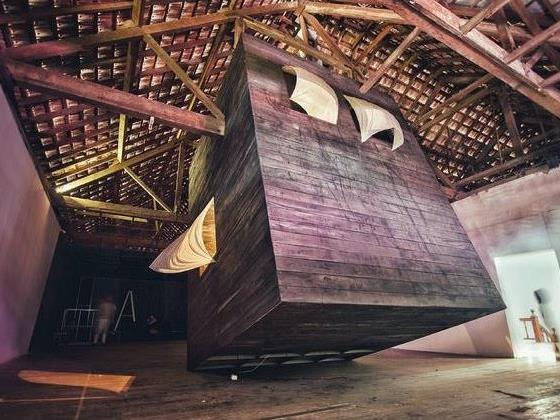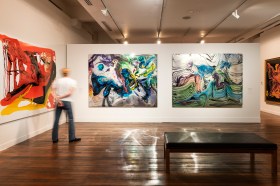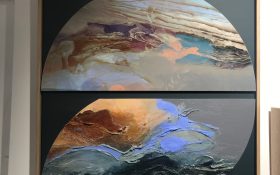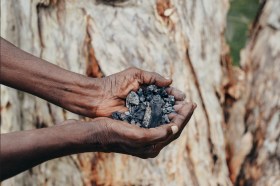Gabriel lester’s installation at Aspinwall; image via Instagram
From the moment I jumped into an auto-rickshaw and began speaking to the driver, I knew I was visiting a Biennale like no other. My driver told me he had visited the Kochi-Muziris Biennale three times to see the exhibitions presented in the re-purposed spice-trading warehouses scattered around the historic island of Cochin (now known as Kochi) in the southern Indian state of Kerala.
This, the third edition the Biennale, called Forming in the Pupil of an Eye, was curated by Artistic Director Sudarshan Shetty from Mumbai, India. The Biennale presents the works of 97 artists from 35 countries including three Australian artists.
Chris Mann continues his fascination with language in his Speaking is Difficult, an audio podcast that could be employed as a kind of idiosyncratic audio tour of the Biennale. Alex Seton’s Refuge presents a carved marble figure wrapped in an emergency blanket, which evokes the issue of asylum seekers searching for a place of safety, and Khaled Sabsabi’s multiscreen 3D video work 70,000 Veils offers an abstract autobiography that examines the connections between religion and spirituality in the digital age.
Sudashan Shetty is a practicing artist. I was interested to ask him what, if any, differences might result from an artist curating the event, rather than a more conventional contemporary art curator. He told me his intention in selecting works was to open up, and flip around the convention of thematic curation. He thought that one of the challenges he faced was to consider if it was possible to sidestep the idea of the curator as the gatekeeper of culture and knowledge altogether, and to become more of a catalyst who manages and provokes a process of creative evolution. His choice of theme was based partly on a traditional story about a sage who gathers the whole world in the pupil of her eyes and reflects it back to a young traveller who has sought her out. He believes that the poetic theme is open-ended enough to engender a multiplicity of creative responses.
Shetty believes that artists can reflect our global realities with multiple understandings and representations of reality. When curating the Biennale, he was not looking for works that would fit into a singular narrative. He thinks that there is something essential about the way we look at the world that is multiple in nature and that all those multiplicities are aspects of a singular stream. For this reason, he included writers, musicians and poets in this Biennale alongside visual artists in order to explore this notion in both form and meaning.
The artist-led nature of this event also extends to the key members of the Foundation who have worked tirelessly to establish the Biennale in Kerala. Co-founders Bose Krishnamachari and Riyas Komu are both practicing artists who persevered with this bold initiative through many funding difficulties and practical hurdles. Their hard-won success is demonstrated by the acceptance now of the Biennale as a key event in the cultural calendar of Kerala, by the funds provided by the Keralan government and sponsors, by the interest in the Biennale amongst the local community, and in the positive recognition of the event by international contemporary artists and audiences alike.
The maritime and cultural history is a theme that has been explored in previous editions. However, the powerful presence of history is inescapable when such evocative locations are employed as the setting of a biennale. Cochin was a major spice trading centre that has attracted merchants for centuries, including the Arabs, Portuguese, the Dutch and most recently the British. It remains a melting pot of cultures and religions, an island of diverse architectural styles, and of crumbling commercial warehouses. The Portuguese explorer, Vasco De Gama is buried on the island. It is the location of one of the oldest Jewish Synagogues in Asia. St Thomas visited it in 52 AD, leaving behind St Thomas Church and a community of Syrian Christians. Shetty notes that, whatever you do, those histories will enter some way or another into the exhibitions. He explained to me that one of the questions that has emerged is about whether or not you can make works that look forward without first looking back. In each work that he has selected, tradition has played an important role.
The multiplicity of perceptions and meaning are all around you as you wander the streets, map in hand, from venue to venue searching for Biennale locations all over the island. I asked Sudarshan Shetty if he thought that the Biennale could take place in any other part of India. His response was an emphatic no. It’s history of multiculturalism is the living culture that is part of everyday experience on Cochin. He thinks that creating an event to bring artists together from all over the world is a natural extension of its history.
He believes that the fact that the Biennale is embraced by the local community is also something to do with this past. He tells me that there are 24 communities that live in this part of Kerala speaking 16 different languages. It is a very egalitarian society. Today the democratically elected communist government, provides effective social services, encourages high levels of literacy and provides an efficient medical system. Like me, he has also engaged in energetic critiques of the event with rickshaw drivers. He notes that It is not just the art-going public who come to the Biennale, but also local families with children who come back numerous times. This could only happen in a place like this. It is very heartening to observe.
It is expected that more than 800,000 people will have attended the event by its close in March 2017. With the addition of a student biennale and a huge leap in attendance from the previous edition, the Artistic Director and the Biennale Foundation members should be justifiably proud of their achievements.
This edition has made a substantial impact on the Indian arts scene, and unusually for a contemporary art biennale, on the local population as well. It has also created a new and dynamic international focus for contemporary arts in the whole Asian region. Shetty has succeeded in creating an event where multiple understandings of global reality have been constructed through exhibiting works selected from all forms of contemporary practice including music, performance, architecture, sound, philosophy, poetry, writing and the visual arts. In Forming in the Pupil of an Eye Sudarshan Shetty and the Kochi-Muziris Foundation have created a Biennale that that is a thought-provoking, energetic and enjoyable experience for artists and audiences alike.
Forming in the Pupil of an Eye – The Kochi-Muziris Biennale
December 2016 – March 2017
www.kochimuzirisbiennale.org





